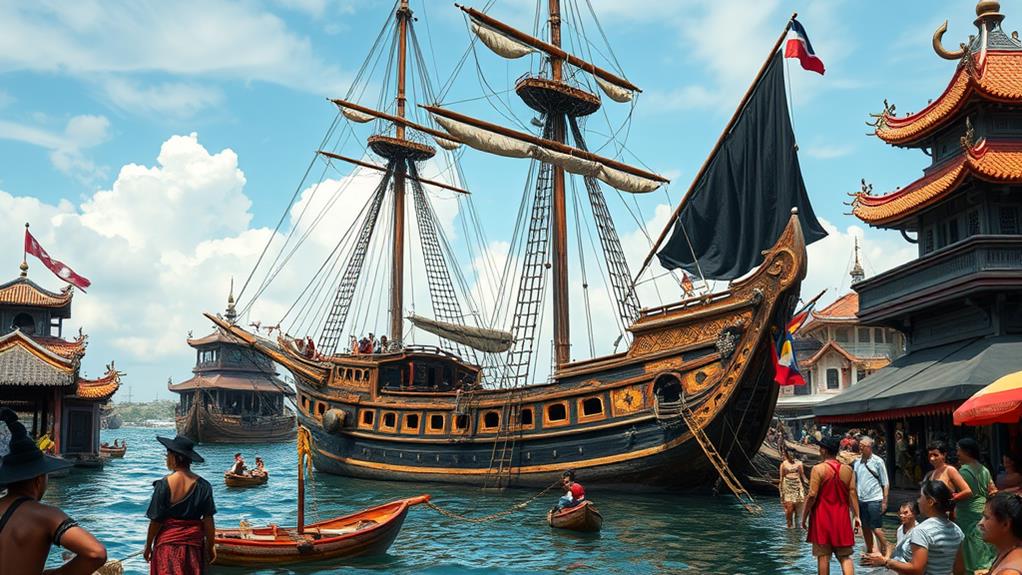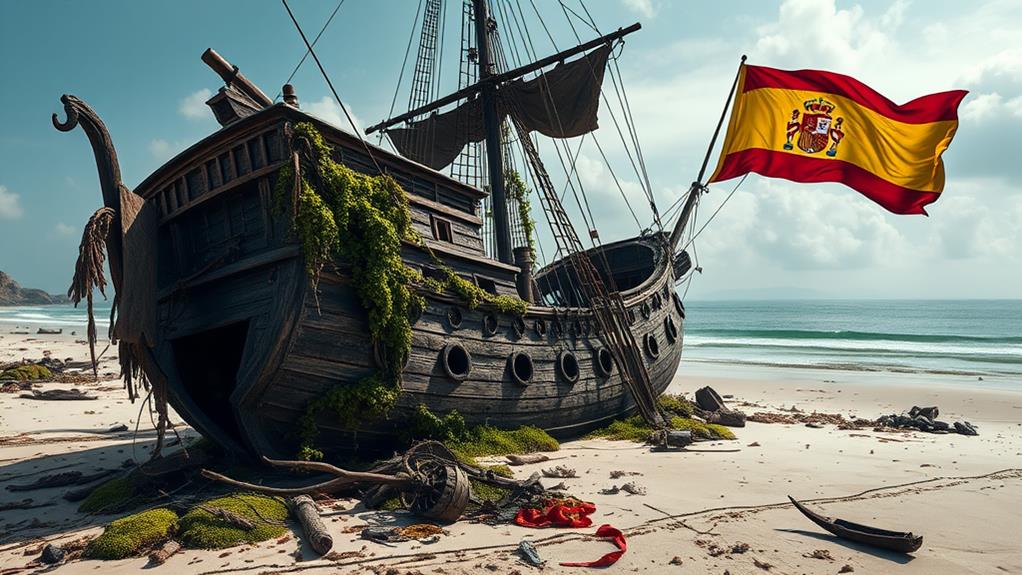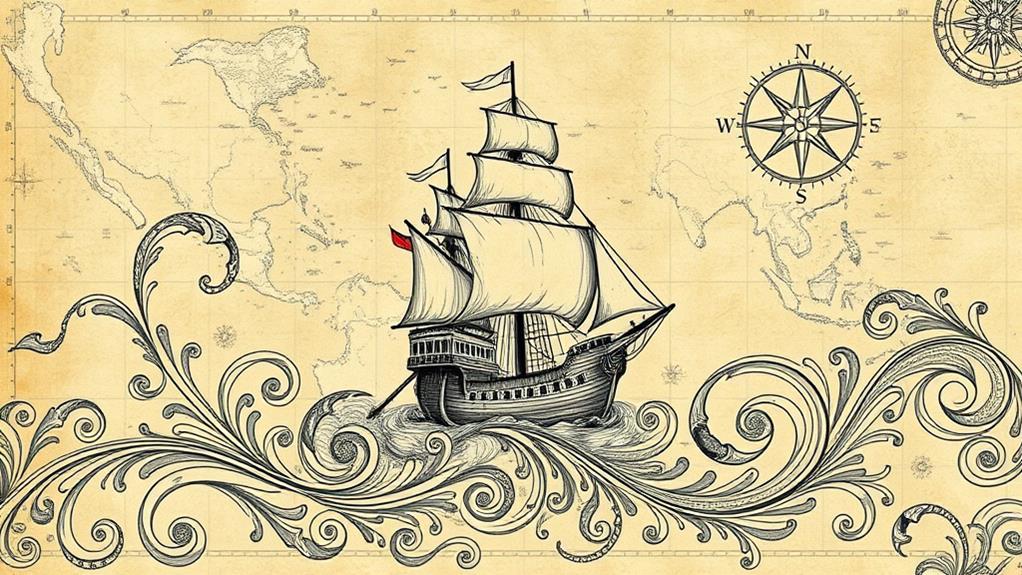The Galleon Trade connected the Philippines to the world through a vast network of trade that spanned the Pacific Ocean. This 250-year era, established in 1565, saw the exchange of luxury goods from Asia for silver from the Americas, with Manila emerging as a key hub for East-West trade.
For example, Chinese porcelain, Indian spices, and Japanese lacquerware were traded for Mexican silver, Peruvian textiles, and Argentine leather goods.
The cultural exchange shaped the identity of the Philippines and the CHamoru people. The Galleon Trade introduced new culinary practices, such as the use of tomatoes, onions, and chili peppers, which became staples in Filipino cuisine.
Additionally, the trade led to the adoption of Christianity, the development of a Latin-based alphabet, and the introduction of Western art forms, such as music and dance.
The legacy of the Galleon Trade continues to influence modern cultural expressions. Today, Filipino cuisine is a fusion of Asian, Spanish, and American flavors.
The country's architecture, art, and literature also reflect the cultural exchange that occurred during this period.
Establishing the Galleon Trade Route
Establishing the Galleon Trade Route
Meticulous planning and navigation were required to connect the Philippines to Mexico, facilitating a global trade route that would last for 250 years.
In 1565, Miguel López de Legazpi established the Manila galleon trade route, a vital maritime link between Acapulco and Manila.
The first successful return route across the Pacific was discovered by Andrés de Urdaneta in 1565, completing the voyage in just 129 days.
Initially, galleon voyages began from Cebu, but in 1571, Manila became the primary port for the trade.
This route enabled the exchange of luxury goods from Asia, such as silk and porcelain, for silver from the Americas.
The galleon trade significantly impacted global trade dynamics, making Manila a key hub in the exchange of goods between East and West.
Goods and Cultural Exchanges
The Manila Galleon Trade Facilitated Cultural and Economic Exchange
Across the Pacific, the Manila galleon trade connected Asia and the Americas, facilitating a rich exchange of goods and cultural practices. This exchange introduced luxury items and played a significant role in disseminating traditional crafts, such as the intricate beauty of Philippine weaving traditions.
Key Goods Exchanged
The trade involved the exchange of luxury goods, including Chinese silk, porcelain, and spices from Asia, which were traded for valuable silver and agricultural products from the Americas.
Culinary Exchange
The introduction of new ingredients and cooking techniques from Mexican cuisine transformed local diets and farming practices in the Philippines.
Agricultural Changes
The adoption of new agricultural products, such as carabao, pigs, corn, and tobacco, significantly changed the way people lived and worked.
Architectural Influences
Architectural changes, such as the construction of stone forts and churches, reflected a blend of Spanish and local influences.
Lasting Impact
The Manila galleon trade had a profound impact on the cultural and economic landscape of the Philippines, shaping the country's cuisine, architecture, and way of life in lasting ways.
Impact of Colonization and Trade

The Manila Galleon Trade's Impact on the Philippines
The Manila galleon trade had a profound impact on the cultural and economic landscape of the Philippines, which was further shaped by Spanish colonization. This influx of foreign influences led to local artisans adopting new techniques, including those from the Spanish Colonial Era.
For example, Filipino craftsmen began to use new materials and tools introduced by the Spanish, such as iron and steel.
The Decline of Traditional Barter Systems
The trade dynamics of the galleon era contributed to the decline of traditional barter systems.
Reliance on imported goods from the Manila galleons overshadowed local production and trading practices, leading to a shift away from traditional exchange systems. This shift was significant, as the Philippines had historically relied on bartering for goods and services.
Changes in Agriculture and Diet
The introduction of new agricultural products by Spanish colonizers transformed local diets and farming practices.
For instance, the introduction of carabao, pigs, and tobacco led to new forms of agriculture and changed the way Filipinos lived and ate. These changes reflect the deep cultural and economic exchanges resulting from colonization.
Architectural Changes
Architectural changes, such as the construction of stone forts and new building techniques, reshaped the physical landscape of the Philippines.
These structures, like Intramuros in Manila, symbolized the enduring influence of Spanish colonial power.
Global Economic Link
The exchange of Asian luxury goods like silk and porcelain for silver from the Americas established a significant economic link between the Philippines and the broader global market.
This exchange solidified the Philippines' position in the global economy, connecting it to a vast network of trade routes.
CHamoru Contributions and Resilience
CHamoru Contributions to the Manila Galleon Trade
The CHamoru people played a vital role in facilitating the Manila galleon trade, showcasing their adaptability, resourcefulness, and cultural resilience.
They established extensive trade networks among Micronesian islands, preparing goods and provisions for galleon arrivals, especially during peak trading seasons in June.
CHamoru Adaptability in Trade Practices
The Matao iron trade allowed CHamorus to exchange local provisions for iron goods with European ships, demonstrating their adaptability and resourcefulness in trade practices.
During galleon stops in Guam, CHamorus provided essential food, water, and crafts, including unique local adaptations like capers and dried beef influenced by Mexican practices.
Strategic Approaches in Trading Interactions
Instances of trickery in barter, such as mixing rice with rocks for profit, highlight the innovative and strategic approaches CHamorus employed in their trading interactions with Spanish and Dutch vessels.
Preserving Cultural Traditions
The CHamorus' ability to navigate the complexities of the galleon trade while preserving their cultural traditions is evident in their preserved traditional fishing practices and language.
They also incorporated new ingredients and techniques into their culinary traditions, showcasing their cultural resilience.
End of the Galleon Era

The Galleon Trade Came to an End in 1815
The CHamoru people's adaptability and resourcefulness in the Manila galleon trade couldn't prevent its eventual decline. The galleon trade ended in 1815 due to the suppression of the galleon route by the Cortes of Cádiz in 1813 and its final confirmation by Ferdinand VII in 1814. The last galleon to arrive in Manila, the San Fernando Magallanes, came empty, highlighting the decline in trade operations.
Shift Away from Traditional Galleon Trade Structure
The Bourbon Reforms, initiated in the 1740s, allowed for solo voyages, signaling a shift away from the traditional galleon trade structure. This change led to increased competition from other trading powers and the emergence of direct trade routes with Asia.
Economic Disruptions and Alternative Trade Routes
Economic disruptions from uprisings in Acapulco around 1813 contributed to the loss of Spanish control over Mexico, prompting the search for alternative trade routes.
As the galleon trade ended, a significant transition in Pacific maritime commerce occurred, ultimately leading to an economic depression in Mexico and the Philippines.
Legacy of Cultural Encounters
Legacy of Cultural Encounters
The Manila Galleon Trade, which took place from 1565 to 1815, facilitated a dynamic exchange of cultural practices and goods between Asia, Europe, and the Americas, significantly contributing to the history of globalization.
This period of exchange mirrors the communal spirit found in Filipino celebrations, where culinary traditions unite communities.
Cultural Exchanges
Food and Cuisine: The introduction of Mexican food items like tomatoes and avocados transformed local cuisine and led to the creation of new dishes like champorado and caldereta.
Documentation and Social Change: Catholic missionaries documented CHamoru lifestyle and beliefs, resulting in significant changes to social and political systems, including the diminished role of ancestor worship.
Local Crafts: The blending of European and Asian aesthetics in local crafts like ceramics showcases the cultural amalgamation that occurred through maritime commerce.
Preserving Cultural Heritage: Community initiatives like the "Voices of Our Elders Project" capture oral histories and cultural practices that highlight the resilience and ongoing adaptation of CHamoru identity.
Lasting Impact
These cultural exchanges have left an indelible mark on the Philippines, shaping its identity and cultural heritage.
Rethinking History and Identity

The Manila Galleon Trade significantly shaped the cultural identity of the Philippines, particularly the CHamoru people. This trade introduced new cultural practices, agricultural products, and trade dynamics that transformed the CHamoru way of life.
Cultural Exchanges and Their Impact
The introduction of Mexican culinary techniques and ingredients transformed traditional Filipino cuisine, leading to a unique gastronomic identity.
Trade practices with Europeans shaped the CHamoru identity through cultural exchanges, resulting in the adaptation of new practices and products. The introduction of new agricultural products, such as corn and tobacco, led to their incorporation into traditional practices, demonstrating cultural resilience amidst colonial changes.
CHamorus as Active Participants in Pacific Dynamics
Historical accounts and artifacts from the galleon trade highlight the complex interplay of cultural identities and CHamoru participation in Pacific dynamics.
The CHamoru people played a significant role as active participants in the trade, interacting with Europeans and other Pacific nations. This rethinking of history and identity demonstrates the complex and dynamic nature of cultural heritage, influencing modern CHamoru cultural expressions.
How Did the Galleon Trade Impact the Philippine Revolution?
The Galleon Trade had a significant impact on the philippine revolution: freedom and independence. The exchange of goods and cultures during the trade route influenced the ideas of nationalism and independence among Filipinos. It played a crucial role in shaping the country’s desire for autonomy from colonial rule.
Preserving Cultural Heritage
Preserving cultural heritage is crucial for honoring the past and shaping the future. The Manila Galleon Trade's impact on CHamoru identity is a prime example, as it resulted in a blend of traditions and practices that are still evident today.
Documenting oral histories is essential for preserving cultural heritage. This involves recording and maintaining the stories and experiences of CHamoru people to enrich contemporary understanding and appreciation of their traditions and practices.
For instance, the Voices of Our Elders Project aims to preserve CHamoru stories and cultural perspectives through video interviews.
Cultural celebrations and festivals play a vital role in preserving cultural heritage. Events like the La Nao de China festival, which highlights cross-cultural ties among Mexico, the Philippines, and Guam, showcase cultural resilience and diversity.
Similarly, the Subayan Keg Subanon Festival is a vibrant cultural tapestry that celebrates the rich heritage of diverse communities.
Preserving culinary practices is an important aspect of cultural heritage preservation. This involves incorporating local ingredients into traditional dishes introduced during the galleon trade, demonstrating cultural adaptability and diversity.
Questions and Answers
What Is the Importance of Galleon Trade in the Philippines?
The galleon trade was crucial in the Philippines because it established the country as a critical hub for global commerce. This trade route connected the Philippines to other parts of the world, enriching the local economy and fueling Spanish colonial profits.
The exchange of Asian goods like silk and porcelain for Mexican silver led to significant cultural and economic exchanges. For example, this exchange introduced new products, agricultural practices, and crops like tobacco, which still impact Filipino culture and economy today.
What Was the Trade Between the Philippines and Mexico Manila Galleon?
The Manila Galleon Trade was a significant exchange of goods between the Philippines and Mexico.
Silver from the Americas was traded for luxury items like silk, porcelain, and spices from Asia. This exchange drove economic interactions between the two regions.
Cargo on the galleons included agricultural products from the Americas, such as corn, beans, and squash.
These products were sourced from New Spain, which is now modern-day Mexico.
In return, around 80% of goods carried on voyages from Acapulco to Manila came from New Spain, highlighting the crucial role of silver in the trade dynamics.
How Did the Galleon Trade Affect Globalization?
The galleon trade significantly contributed to modern globalization by establishing a regular exchange between Asia and the Americas. This exchange initiated a new era of global connectivity, fostering competition among nations and altering global trade dynamics.
For instance, European powers like Spain, Portugal, and the Netherlands competed to establish trade routes, leading to the emergence of new trade centers and economic powers.
The galleon trade facilitated the rapid circulation of goods, promoting cultural diffusion and the blending of practices. As goods like spices, textiles, and porcelain moved between Asia and the Americas, cultural influences also traveled.
For example, Asian spices like cinnamon and pepper became staples in American cuisine, while American crops like maize and potatoes were introduced to Asia. This exchange of goods and ideas contributed to the development of diverse cultural practices and traditions.
What Is the Event That Led to the Opening of the Philippines to World Trade?
The establishment of a trade route by Miguel López de Legazpi in 1565 led to the Philippines' opening to world trade. This route connected Manila to Acapulco, Mexico, sparking a new era of global commerce.
Through this route, luxury goods and resources were exchanged between Asia and the Americas.
This event marked the beginning of the Philippines' integration into the global economy, setting the stage for cultural and economic transformations.